Final report for YENC09-011
Project Information
PROJECT DESCRIPTION AND RESULTS
BACKGROUND
I have been educating youth since 2000. My main focus has always been on the sustainable use and management of resources for agriculture, namely soil and water conservation. One activity that we do each year is to educate 600 fourth-graders on agriculture. The students come to a farm near our university campus and I spend only 10 minutes with each class discussing soil conservation.
In addition, for the past three years I have taught Boy Scouts for one afternoon in order for them to earn the Soil and Water Conservation Merit Badge. This is an activity that we conduct on our university farm as well, and the Boy Scouts help to design a conservation plan.
I have instructed girls in middle and high school about soils as well in two programs for young women interested in STEM (science, technology, engineering, and math). These programs usually involve a session that lasts a few hours with hands-on learning.
GOALS
As the name of our grant indicates, I wanted to make a meaningful experience happen for fourth grade boys and girls. My goal was to have them observe the linkages between what happens on the land and what happens to bodies of water as a result. The children we targeted live in the watershed above Cheney Reservoir, which is a main source of drinking water for the City of Wichita, Kansas. Though the children lived on farms or in small, rural communities, many of them did not understand agricultural production well. Therefore, one of the goals was to have them speak to a farmer. We encouraged the farmer to talk about what they raised, where they lived, and what conservation meant to them, including practices and measures they were taking on their own land. Another goal was to have the children sample soil and learn about soil properties and the biology of living soils. Finally, we asked them to bring water samples from home or elsewhere to teach them about properties of drinking water and how to test for nitrates and phosphorous.
PROCESS
One overarching goal we had was that we wanted to have more than one contact with the students. So many of my previous work with youth has only been one brief period of time. For this project, I met with the classes twice. Also, from these previous experiences with this grade, I have learned that learning the steps of the scientific method is a concept they learn, and their teachers appreciate it when the students have another project or experiment to apply this training to.
On the first visit to each classroom I instructed them to collect a water sample for the next time that I visited. It was very rewarding to me on that second visit when I saw how excited the students were to tell me about where they had sampled their water, why they had decided to sample that place, etc. At all four of the classrooms there was a student who had forgotten to collect a sample, and so we encouraged them to think about where they could go inside their classroom or school to get a sample, and I think that all four sampled the class fish tank. During this entire process we used the scientific method, observe, hypothesis, test, and conclude, and asked the students to work on their hypotheses. One way in which we reinforced this was to ask them to line their samples up in order of what they thought would have the least nitrates, and which would have the highest nitrates. Then they tested the samples with our help and guidance using routine water analysis kits, purchased with the grant funds. There were some interesting conclusions. For example, one small town uses wells for drinking water, and the nitrate levels were around 10 parts per million (10 ppm). That is above the safe drinking water limit, and so their teachers and I explained why that wasn’t safe for babies or pregnant women to drink. It was very neat to see a few of the students realize that this is exactly the reason that their baby brothers and sisters drank formula made with bottled water (provided by the town to expectant and new mothers).
The other activity that we did on the first trip to the classrooms was to invite a farmer to come to each class and speak on their farming methods. We also asked the farmer to talk about sampling their soils, and the farmers all brought soil probes. We went outside into either the school’s garden or into a grassy area of the playground and examined the soils. We did not take any samples, but this was more of an opportunity to talk about the fact that soils have layers, and what topsoil is and why plants prefer to grow where there is healthy topsoil.
In addition to the linkages between soil and land use and water quality, we also took the opportunity to teach the students about earthworm ecology, such as about the fact that earthworms are hermaphroditic, that they have several hearts per worm, that you can identify them by counting body segments, how to tell a mature worm from a juvenile, and that if you cut a worm in half, you get a dead worm, not two worms. Each student was given a live wriggling night crawler and they really enjoyed this part of the hands-on experience. Once we were finished with the worms the students put them in the school garden or in the grassy areas of the playground.
PEOPLE
Educators, Schools, and Students:
Carmon Unruh, Partridge 3rd and 4th Grade Teacher (Students = 20)
Pat Garwood, Fairfield 4th Grade Teacher (Students = 23)
Dennis Detter, Pretty Prairie 4th Grade Teacher (Students = 12)
Stephanie Gehring, Pretty Prairie 4th Grade Teacher (Students = 13)
Role: Allowed us to come into their classrooms twice. Teachers also reminded students to bring soil samples for our first visit, and water samples for our second visit.
Local Farmers:
Darrin Unruh, Pretty Prairie
Ryan Jacques, Partridge
Derek Zongker, Fairfield
Role: Spoke to the classroom about their farms and how they manage their land to improve water quality in streams, the Ninnescah River, and ultimately Cheney Reservoir. All spoke about farming their cropland using no-tillage and diverse cropping systems including cover crops.
Non-Profit Organization Staff:
Lisa French, Cheney Watershed Inc.
Howard Miller, Cheney Watershed Inc.
Role: This is a local organization that works to improve the water entering Cheney Reservoir by working with landowners in the watershed.
Kansas State Research and Extension personnel:
Dr. DeAnn Presley, Department of Agronomy
Dr. Peter Tomlinson, Department of Agronomy
Note that Dr. Tomlinson began working at Kansas State University after this grant was applied for, but I asked him to participate in this project because of his training in earthworm ecology. We brought night crawlers to the classes and this was some of the students’ favorite part of the experience.
RESULTS
Our results included the classroom findings. In general, we observed safe drinking water for nearly every student in the Fairfield and Partridge classrooms, but found that there were high nitrates in Pretty Prairie. As for phosphorus, there were some rather high values obtained. A photo of the data records are included with this report.
Our audience is 4th graders in the Cheney watershed. We did not do any learning assessments to test whether or not the students learned anything.
I hope that we reinforced the process of the scientific method, and that we exposed the students to the life of a professional scientist, and got the students to think about the connectedness of the watershed and its soils and use and management.
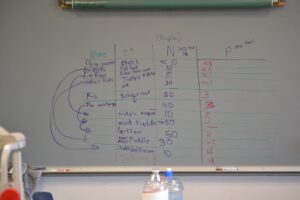


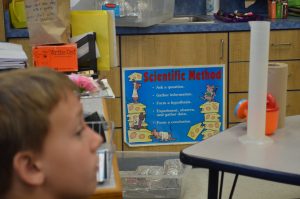

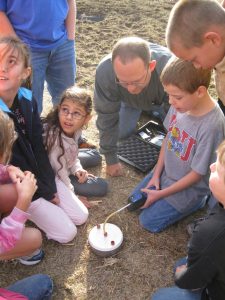
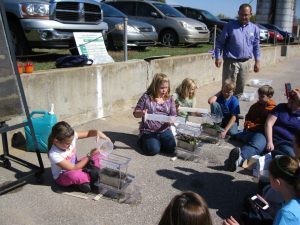

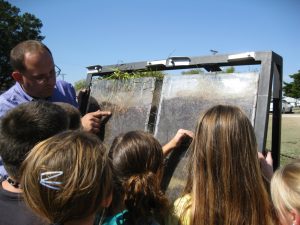
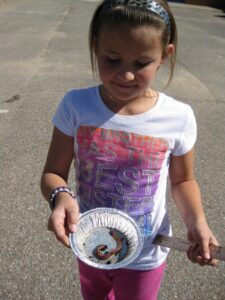
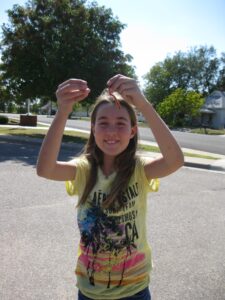
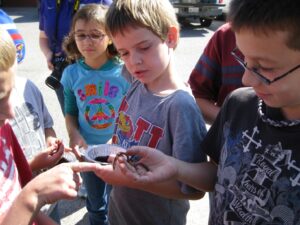
DISCUSSION
From completing this project I learned, once again, how rewarding it is to work with youth. One thing I have not mentioned thus far in this report is that in these small rural communities, I learned it is quite rare for any of the students to have met a professional scientist before. I think it is very, very important to show students some role models throughout their lives. Not only am I a scientist, but I am a female scientist and I am around the same age as some of their parents. I spent maybe 3-4 minutes talking about what it means to be a scientist, the fact that I went to college, etc., and I think the students really found this different and memorable.
One thing that I would change if I were to do this project again would be to work with the teachers to assess student learning. That was something we failed to do with this project, but will certainly do again in the future.
PROGRAM EVALUATION
I don’t have any strong opinions about the program itself, other than to say that I think it is a fantastic program. I believe it gives educators enough money to plan and execute some local learning events and as I said, completing the project and working with youth is a very rewarding experience.
Educational & Outreach Activities
Participation Summary:
We considered the project itself outreach, so the people that we reached were the classrooms and their teachers. There was only one newspaper clipping that reported the activities and it is included with this report.
The Ninnescah Valley News, November 23, 2012: PP 4th grade students learn about soil and water quality.